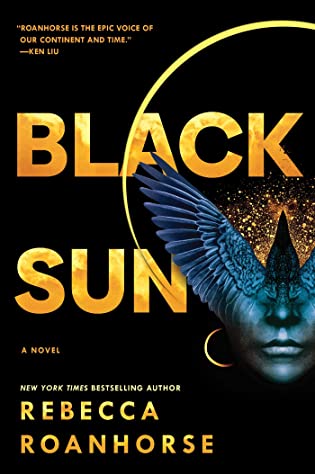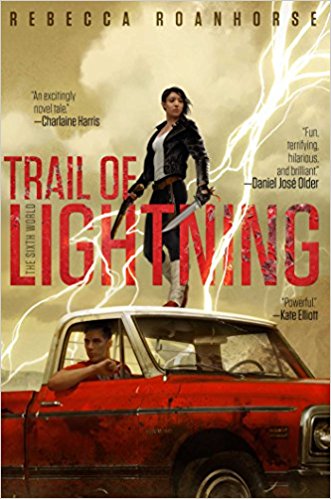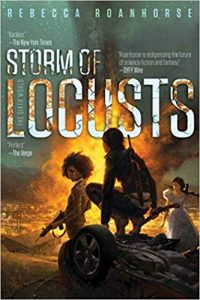 Black Sun (Between Earth and Sky, #1) by Rebecca Roanhorse
Black Sun (Between Earth and Sky, #1) by Rebecca Roanhorse Format: eARC
Source: supplied by publisher via Edelweiss
Formats available: hardcover, ebook, audiobook
Genres: epic fantasy, fantasy
Series: Between Earth and Sky #1
Pages: 464
Published by Saga Press on October 13, 2020
Purchasing Info: Author's Website, Publisher's Website, Amazon, Barnes & Noble, Kobo, Bookshop.org
Goodreads
From the New York Times bestselling author of Star Wars: Resistance Reborn comes the first book in the Between Earth and Sky trilogy, inspired by the civilizations of the Pre-Columbian Americas and woven into a tale of celestial prophecies, political intrigue, and forbidden magic.
A god will returnWhen the earth and sky convergeUnder the black sun
In the holy city of Tova, the winter solstice is usually a time for celebration and renewal, but this year it coincides with a solar eclipse, a rare celestial event proscribed by the Sun Priest as an unbalancing of the world.
Meanwhile, a ship launches from a distant city bound for Tova and set to arrive on the solstice. The captain of the ship, Xiala, is a disgraced Teek whose song can calm the waters around her as easily as it can warp a man’s mind. Her ship carries one passenger. Described as harmless, the passenger, Serapio, is a young man, blind, scarred, and cloaked in destiny. As Xiala well knows, when a man is described as harmless, he usually ends up being a villain.
Crafted with unforgettable characters, Rebecca Roanhorse has created an epic adventure exploring the decadence of power amidst the weight of history and the struggle of individuals swimming against the confines of society and their broken pasts in the most original series debut of the decade.
My Review:
Start out by throwing out any expectations you might have about good versus evil and/or heroes versus villains that might have popped into your head because this Black Sun is labelled as high fantasy or epic fantasy.
We have protagonists here. Points of view. Perspectives. But strictly speaking all of the characters are operating somewhere in the grey, in the shadows created by the solar eclipse that produces the “black sun” of the title.
Everything in this story is on a collision course with that eclipse, an event that the Sun Priests of the great city of Tova call the Convergence. This particular Convergence is going to occur on the Winter Solstice, as the moon eats the sun on the shortest day of the year. And the Sun God is at the lowest point of his power. A point where he might be challenged.
An event that this time, on this once in a lifetime occasion, could result in overturning the balance of the world.
But we begin at the beginning, when a woman sacrifices her life to make her son into an offering – or an opening – for the god of her people. Now blind, scarred and rejected by his father, Serapio faces a series of cruel tutors who prepare him for the role that his mother ordained for him.
This is the story of his journey to meet his destiny. But he is not the only person who will rise or fall on the prophesied day.
His story intersects with two others, a disgraced ship’s captain and the deposed leader of the Sun Temple.
And this is the point where the story could go any number of typical directions – but doesn’t.
Serapio could be the hero – but he can only achieve his destiny by killing the entire hierarchy of the Sun Temple. The Sun Temple should be the forces of good, but they have been corrupted by power and cast out the only truly good person among them.
Captain Xiala should be entirely self-serving, but instead shows Serapio the wonders of the world, just as he is about to leave it.
This is a story where nothing is as it seems – and marvelously and magically so.
Escape Rating A: Epic fantasy, which this oh-so-very-much is, usually wraps its dramatic tension around an epic – hence the name – battle between good and evil. That just doesn’t happen here, and now that I think about it, that feels like something that’s not been happening for a while, in spite of the genre’s reputation for it. And I don’t expect one here, not even later in the trilogy. In spite of this being epic fantasy rather than space opera, Black Sun is very much a romance of political agency.
Not that there isn’t plenty of evil – and a smattering of good – but it’s human scale evil and human-shaped and sized good.
The one unequivocally “good” character in this story is Naranpa, the Sun Priestess of Tova and the leader of the world-spanning religion that is centered in the city. She knows that her order has stopped serving its people, becoming isolated and insular in their literal ivory towers, spending all of their time and energy on petty, political squabbles amongst themselves.
The Sun Temple hierarchy is “evil” but it’s the human evil wrapped around the aphorism about power corrupting and absolute power corrupting absolutely. The Sun Temple has had nearly absolute power and it has corrupted them. It has corrupted them so deeply that they depose and attempt to murder the one person within their ranks who even attempts to call them on it.
Part of that evil is that they conducted a purge, essentially a pogrom of religious persecution, against one of the population groups within the capital that did not completely bow down to the supremacy of the Sun Temple. And they are planning to do it again in order to remain in power. Serapio’s quest, the duty that he was created for, is to give his people, the Carrion-Crows, vengeance for that purge – and to prevent a repeat by purging the Sun Temple first.
But we follow Serapio’s and Naranpa’s stories, giving both dimensions a human face and a human scale. In spite of Serapio’s purpose as the avatar of his people’s god, he’s still very human, and we feel for him on his journey, just as we suffer along with Naranpa’s hopes and fears as her hopes for her temple are dashed and her fears are made manifest.
As I read Black Sun, I kept having this feeling that it reminded me of something that I couldn’t quite put my finger on. At first I thought it was Banewreacker and Godslayer by Jacqueline Carey. That duology was one of the best presentations about “good” and “evil” being in the eye of the beholder – along with the eye of the victorious historian – that I have ever read. Those books always come to mind in situations like this one, where those concepts feel more like a wheel where the perception of which is which depends on the position from which they are viewed.
But in the end, and after much discussion, I was presented with the possibility that the story this most reminds me of is A Memory Called Empire by Arkady Martine, even though Empire is space opera and Sun is epic fantasy. Those two genres are so far apart as to come together on the other side of the wheel, after all.
It’s not just that both Black Sun and A Memory Called Empire are utterly awesome, although they both certainly are. Nor is it that both have their mythological underpinnings somewhere other than the much too familiar trappings of Western European mythology.
There were two factors that contributed to that nagging sense that the books had more in common than met the eye. One was the portrayal of the empires, because yes, the Temple of the Sun is the heart of its own kind of empire. Both empires publicly espouse the idea that they serve their people, perversely by deciding things for them and suppressing any dissent. Both are actually completely insular and riddled with backstabbing politics and double-dealing corruption. And both are shaken to their foundations by an internal reformer at the top who is ruthlessly suppressed by the political insiders.
At the same time, both stories also feature a journey by someone who must travel from far outside into the dark heart of that empire, someone who has faced opposition to their mission from before its beginning, and someone whose mission is not entirely clear to them even as they carry it out.
And both stories end in ways that none of their protagonists expected at the beginning, in ways that none of them even believed were possible, let alone likely, but ways that are going to fuel the action in the next chapter of their respective sagas.
I don’t know when the second book in the Between Earth and Sky trilogy will be coming out. But I already can’t wait to see what happens next!

 Trail of Lightning (The Sixth World, #1) by
Trail of Lightning (The Sixth World, #1) by  Elements of this story had echoes for me from other SF and fantasy that I have read. The post-flood US of
Elements of this story had echoes for me from other SF and fantasy that I have read. The post-flood US of